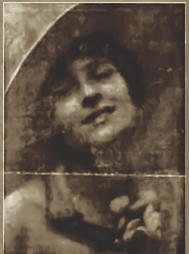
Maria Ginanni (1891-1953)

- Maria Ginanni, in: L'Italia Futurista 2:7 (1. April 1917), p. 4.
Attracted by the avant-garde circle around Emilio Settimelli, Filippo Tommaso Marinetti, and the brothers Ginanni Corradini (Bruno Corra and Arnaldo Ginna), Maria Crisi came to Florence in the middle of the second decade of the twentieth century. There she had a formative influence as an editor and author on the periodical “L’Italia Futurista” from its foundation in 1916 onwards. Maria Ginanni, as she signed since her wedding with Arnaldo Ginanni Corradini, contributed poetry and prose, as well as critical statements to almost every issue. It is remarkable that Ginanni, whose colleagues were constantly full of praise for her (Marinetti: “Prima scrittrice d’Italia”, “Il più formidabile genio che abbia l’Italia”), never really considered herself a “futurista”, but obviously rather endeavoured to maintain her artistic independence.
In 1917, she took over the editorial work of the series “Libri di valore”, which was released along with “L’Italia Futurista”. Its start is marked by the publication of Ginanni’s own prose anthology “Montagne trasparenti”.
After the termination of “L’Italia Futurista” Ginanni was involved in the new establishment of the periodical “Lo specchio dell’ora”, of which, however, only two issues were to be published. Furthermore, she continued to work as an editor for Facchi at Milan where, in 1919, her second book of poems “Il poema dello Spazio” was released.
Like many of her contemporaries, Maria Crisi didn’t consider scientific findings and spiritual experience mutually exclusive; rather did she discern them as complements. Hence she began to study Mathematics in Rome, while also frequenting the spiritualist circle around Annie Besant and the “Società teosofica romana”.
Maria Ginnani’s lyrical prose deals with the synaesthetic and linguistic transcending of modern worlds of experience (taking only in account, for instance, the titles: “Luci trasversali”, “Trasparenze”, “Novelle colorate”). The internalisation and subjectification of meticulous observations lead to extreme experiences which, in the end, can be considered means of self-knowledge.
In the 1920s, Maria Ginanni married Ludovico Toeplitz, with whom she consequently published two collaborative works, which, however, reveal a break with these previous tendencies.
Cited Literature:
Minciacchi, Cecilia Bello (ed.): Spirale di dolcezza + Serpe di Fascino. Scrittrici Futuriste Antologia, Naples 2001, p. 87-128.
Nazzaro, Gian Battista: Maria Crisi, in: Ezio Godoli (ed.): Il dizionario del futurismo, Florence 2002, p. 329-330.




